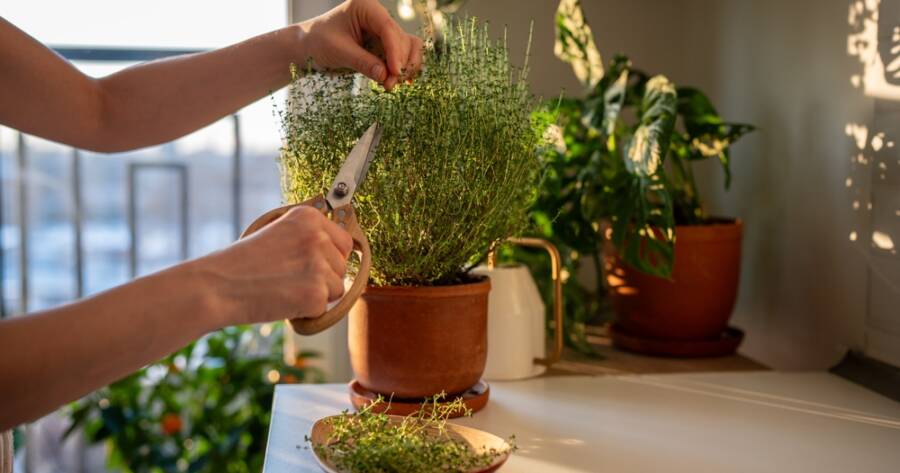Growing your own herbs indoors is a rewarding and practical hobby that can transform your cooking, brighten up your living space, and provide fresh ingredients year-round. Starting an indoor herb garden doesn’t require much space, specialized knowledge, or a green thumb—just a little time and attention. If you’re new to gardening, explore a beginner-friendly guide to help you get started with your own indoor herb garden.
Choose the Right Herbs
The first step in starting an indoor herb garden is selecting the right herbs for your space. Some herbs thrive indoors more easily than others, and choosing the right varieties can set you up for success. Popular herbs for indoor gardens include:
- Basil: A sun-loving herb perfect for windowsills.
- Mint: Easy to grow and fast-growing, but be sure to contain it in a pot as it can become invasive.
- Chives: Low-maintenance and can grow well with just a bit of sunlight.
- Parsley: A versatile herb that adapts well to indoor environments.
- Thyme: A hardy herb that requires minimal care and is perfect for smaller spaces.
It’s essential to choose herbs that match your living conditions. Most herbs require a good amount of sunlight, so keep that in mind when selecting which ones to grow. Herbs like basil and parsley thrive in bright light, while mint and chives can tolerate slightly less light.
Find the Right Containers
Next, you’ll need containers to plant your herbs. If you’re growing from seeds, choose containers that are deep enough to allow the roots to grow and drain properly. If you’re starting with herb seedlings, small pots or even repurposed containers can work well. The key is to ensure that the pots have drainage holes at the bottom to prevent water from accumulating and causing root rot.
Consider using small ceramic or plastic pots, but avoid containers without drainage. If you want to keep things simple, there are also indoor herb garden kits available that include all the materials you need, such as pots, soil, and even plant markers.
Choose the Right Soil
Using the right soil is crucial for the health of your herbs. Opt for a well-draining potting mix designed specifically for indoor plants or herbs. Avoid using garden soil, as it may be too dense for container gardening and can harbor pests or diseases.
A good potting mix will provide the nutrients your herbs need and allow water to drain properly, preventing soggy roots. You can also add perlite or sand to improve drainage if you’re concerned about moisture retention.
Find the Best Spot for Sunlight
Herbs need sunlight to thrive, so choosing the right location in your home is crucial. Ideally, your herbs should receive at least 6-8 hours of sunlight each day. A south-facing window is often the best spot, as it receives the most direct sunlight. However, if your home doesn’t get enough natural light, you can supplement with a grow light.
Grow lights are affordable and come in various styles, including LED and fluorescent options, to mimic the natural sunlight your plants need. Make sure the lights are placed 6 to 12 inches above the herbs and are on for 12-16 hours a day to keep your plants healthy.
Watering and Care
Herbs require regular watering, but it’s important not to overwater them. The soil should be kept consistently moist but not soaking wet. To determine when it’s time to water, stick your finger into the soil about an inch deep. If it feels dry, it’s time to water. If it feels damp, wait a day or two before checking again.
Make sure the pot has drainage holes to avoid water buildup, and allow any excess water to drain out. If you’re growing multiple herbs, keep track of their specific watering needs, as some may require more moisture than others.
Prune and Harvest Regularly
Pruning your herbs encourages healthy growth and helps maintain their shape. As your herbs grow, trim back any leggy or dead leaves to promote more compact and fuller plants. For herbs like basil, regularly cutting the tops off encourages more growth, ensuring that the plant remains productive.
When harvesting, always take a few leaves at a time rather than cutting the entire plant. This will allow the plant to continue growing and producing more leaves for future use. Use fresh herbs in your cooking or store them by drying or freezing them for later use.
Fertilizing
To keep your herbs healthy and producing throughout the season, they may need occasional fertilizing. Use a balanced, water-soluble fertilizer designed for indoor plants or herbs. Apply the fertilizer once every 4-6 weeks, following the instructions on the label to avoid over-fertilizing.
If you’re using a nutrient-rich potting mix, you may not need to fertilize your herbs often, especially during the first few months. However, as your herbs grow and their soil depletes, they will benefit from the additional nutrients provided by fertilizer.
Pest Control
Although herbs are relatively low-maintenance, they can still attract pests like aphids, spider mites, or whiteflies. To prevent pests, keep your plants clean and remove any dead leaves or stems. If you notice pests, try using natural pest control methods, such as neem oil or insecticidal soap, to treat the plants without harming them.
Regularly check the leaves and stems for any signs of pests or diseases and act quickly to remove them.
Enjoy Fresh Herbs Year-Round with Your Indoor Garden
Starting an indoor herb garden is an easy and rewarding way to grow fresh ingredients right at home. By choosing the right herbs, containers, and soil, providing adequate sunlight and water, and keeping your plants healthy with regular pruning and care, you can enjoy a thriving herb garden indoors. Whether you’re an experienced gardener or a complete beginner, an indoor herb garden is a great way to enhance your cooking and bring a touch of nature into your home.

